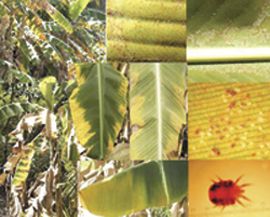Banana disease still unknown, new threat looming

The Ministry of agriculture is facing a deadly two-edged sword; a dangerous disease affecting our banana industry and a tiny menace of a mite that could threaten the coconut and banana industries.{{more}}
Last week, Agriculture officials confirmed that they were battling an unknown disease that has been destroying tissue culture bananas but were unsure as to its identity.
Chief Agricultural Officer Reuben Robertson told SEARCHLIGHT earlier this week that local experts at the Plant Protection and Quarantine Unit have identified the disease as being a Banana Wilting Disease.
Robertson said that while they needed verification of the plagueâs identity by an accredited institution before any official notification could be made, they are confident that they have it right.
Robertson said that they must move quickly and systematically to destroy the disease because it has the potential to wipe out the entire banana industry.
âWe need to work together on this and will need the cooperation of all the players, especially the farmers,â he said.
Agriculture officials will however be doubling their efforts as they prepare for the possible arrival of the equally dangerous Red Palm mite that is menacing and spreading quickly in the Caribbean.
âWe are on the lookout for it, we have a surveillance team in place,â said Robertson when SEARCHLIGHT inquired about the Red palm mite.
While the mite has not been spotted in St Vincent and the Grenadines, Robertson said that he is aware that it has affected several countries in the region.
Among the Countries where the mite has been doing damage are Guadeloupe, Martinique, St Martin, Trinidad and Tobago, St Lucia and Dominica.
Although the pest has been affecting mainly palm and coconut trees, in Dominica it has attacked banana plants.
Among the miteâs calling cards are yellow spots or totally discoloured palm leaves as well as reddish-brown areas indicating mite clusters.
First described in India in 1924, it is a significant pest in the Philippines and Egypt. The mite can also disperse via the wind.
A United States Department of Agriculture (USDA) release on the pest quotes Ronald Ochoa, a world-renowned mite expert as saying âThereâs no question that hurricanes or human activity will eventually spread R.indica (the red palm mite) to tropical and subtropical regions throughout the Americas.â
Ochoa further said in the USDA report: âItâs vital that the affected Caribbean islands be surveyed as soon as possible for this mite, beginning in Trinidad, where itâs out of control.â
While the surveillance team is in place here in St Vincent and the Grenadines, Robertson said that one major challenge facing them is that a lot of our coconut trees are very tall, which could make the close up examination necessary challenging.
Last week Agriculture Minister Montgomery Daniel defended his ministryâs handling of the banana disease outbreak in the face of criticism by Opposition Leader Arnhim Eustace, saying that no announcement could have been made on the issue because the identity of disease was unknown.
Eustace made his remarks during a televised address to the nation two weeks ago.
Samples of the affected banana plants were sent to the Global Science Laboratory in the United Kingdom over a year ago.
Robertson confirmed to SEARCHLIGHT earlier this week that fresh samples were sent to the laboratory again last week.
âThey assured us that they would be working on it expeditiously for us this time,â Robertson said.









